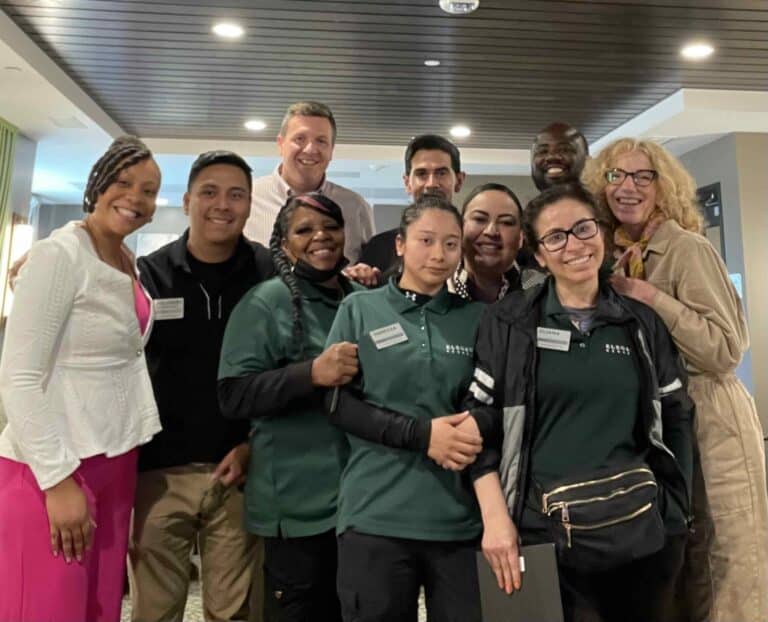“I think humans are at the core of battling COVID when it comes to their organization. Human beings are the shock absorbers of the system. Having benefits that are all encompassing has been a real blessing in some of the companies that I’ve been at, because they’re not treating me or any other employee just as a widget, but instead as a living, breathing system that needs to be nourished and kept alive.”
– Dipti Sirisinahal, People Leader at Google
Overcoming Systemic Stress due to Workplace Changes
In the age of the knowledge worker we understand that most of a company’s value is with its people. Talent matters, retention matters, culture matters, people matter.
We know this, right?
But when we face intense corporate stressors like COVID-19 or widespread layoffs that knowledge needs to be kept front and center. We’ll be able to apply specific tactics to help employees navigate the stress from these events.
Panelists from our discussion on building resilient companies touched specifically on how to navigate challenges caused by:
- COVID-19 and returning to the office
- Layoffs and corporate restructuring
- Work from home with kids
What follows is a transcript of this portion of the conversation, edited for clarity and readability. In it we explore how companies can better navigate these situations in order to emerge more resilient.
Treat Employees Like the Humans They Are
Before we jump into the three categories of stress mentioned above it’s important to level set. Your company (and especially your human resources folks) need to understand that we’re all human. And everything that’s done should be with this in mind.
So I think whether it’s at Google, whether it’s Box [where I was before] what we’ve done is we have a lot of tools around stress management, whether it’s the Calm app for our employees, whether it’s something like Burnalong, to make sure that people are staying fit. Or Eatology, of course, that helps you do more mindful eating.
[It’s imperative to] come up with benefits that not only support the health of the employee, but also take care of their support system. So whether that’s their spouse, their parents, their children, what have you. Having benefits that are all encompassing has been a real blessing in some of the companies that I’ve been at, because they’re not treating me or any other employee just as a widget, but instead as a living, breathing system that needs to be nourished and kept alive.
How HR Can Lead Through Layoffs and Restructures
Key principles include:
- Act decisively. Don’t stagger layoffs over time.
- Reassure the people who remain that they’re the future.
- Communicate early and often to lessen the impact of doing this remotely
Make your moves and then tell people that are remaining that they’re the ones that are going to be on the team to help move the organization forward.
And [if you don’t communicate this with absolute clarity] the people remaining begin to go back think about safety and security and Maslow’s hierarchy of needs. They start to think about “what about me, what’s going to happen to me”.
The other thing related to that is I think you need to do it. You tell people what you know when you know it and you move on it as quickly as possible. You’ve heard countless stories and there have been many things written about things that get drawn out. Rumors start. People will tend to go to the negative aspects of their life and come back to “am I going to be affected by this?” And so the more defined it can be, the quicker it could be executed. And the sooner you’re able to move on, the better off it’s going to be.
What makes it even more challenging during this period is it’s always been better to be able to do those things in person. And when the people that are making those decisions can look other people directly in the eyes and say, “OK, we are where we are, we’ve done what we’ve had to do now let’s well, let’s all work together to move on.” That becomes even more challenging now. I think that’s why communication is even more critical today than ever before, because it’s hard to make that personal connection over Zoom like you would be able to do in person.
Maintaining Great Company Culture Through Tough Times
Step 1: Keep Formal and Informal Connections Robust
Despite challenging conditions during COVID-19, Bloomberg has been adamant with its employees that they will return to the office. Here is Ken Cooper, the head of HR, on how to communicate something this sensitive and maintain trust and loyalty with the workforce.
What we’ve seen and what studies are already showing in this environment is that the relationships employees have are more vertical than horizontal. They have the relationship with the people that they work for specifically and work with. But the the horizontal relationships that they often have, where they’ll interact with people that aren’t as close to their team or aren’t as connected to the team are becoming more frayed in this environment because they just don’t run into and see those people. You have to just work at keeping it going.
The horizontal relationships that they often have, where they’ll interact with people that aren’t as close to their team or aren’t as connected to the team are becoming more frayed in this environment because they just don’t run into and see those people. You have to just work at keeping it going.
I’ll give you an example. One thing we’re doing is one of our engineers created a piece of software called Coffee Roulette. And it just may sound a little cheesy, but what it is, is it randomly grabs multiple, like three employees, says here, go get a cup of coffee together, virtually. And since it’s a random selection, you’re getting people to meet each other and interface with each other that may not otherwise do that. That’s one thing. I know other companies that are using Slack. There is a company that has an add in to Slack that does just that, in an even more sophisticated way. If I remember the name, I’ll mention it. But I met with them. It’s a great company. So there are things you have to do there.
But we’re social animals. At the end of the day we’re social animals. We like being with each other and we’re seeing that around the country. People, even though they know it might not be safe, are foolishly getting together in big crowds because they’re social animals. They want to be together. And we should just never forget that we just have to be safe.
And we’re looking at ways in which we can be better on Google Hangout or doing whatever you say. Because it’s very hard to read the energy of the other person when you’re in a virtual setting one hundred percent of the time. So using certain tools that can help you be a better listener while you’re on call is something that we started to do. And it’s literally it’s a little Chrome plug in that’s, I think, called Good Listener. I think anyone can get it. And it tells you the percentage of time you talk in a meeting, versus how much time you listen. And that actually then helps people understand how they’re contributing to every meeting that they’re part of and also gives an opportunity for us to bring in the diverse perspectives that we should in every meeting.
Step 2: Make People Feel Involved in Key Decisions
I think the more engaged you can make people and the more you can respond back to those those thoughts and those ideas the better off the organization will be. And don’t care about who gets credit for it, but call people out (in a good way). Public recognition and ways for people to feel like they are still making a difference to the organization is hugely important, because as has been mentioned now several times by the panelists, it is tougher, much tougher because we are social folks to read the energy, read the positivity and really engage with individuals.
So I think the more things we can do to maintain that positivity and things like calling people out for good ideas, recognizing folks, simple thank yous for things that are going on well, so that even though it’s virtual, people can kind of feel the pat on the back. While they may not be in a room with someone, they can still feel that that positivity coming from the organization. And so I think the more there’s encouragement, recognition and making people part of those solutions, I think all are positive ways to keep moving everyone in the same direction.
It’s all about Culture, Communication, and Community
The common theme for how companies can navigate stressful events and emerge more resilient lies in developing, maintaining, and even strengthening the ties between people before, during, and after these stressors occur.
It starts with building a strong, positive culture where people feel they have agency in contributing to the solution to whatever problem you face. That involves honesty, communication, and structures to facilitate feedback and ideation.
From there you need to keep people plugged into one another. While that’s harder when you’re remote, it’s essential to have mechanisms to not only foster the relationships with people that work directly with one another but also to maintain the looser, horizontal ties that bind a company together.
Finally, leadership needs to act decisively and courageously when faced with unavoidable situations and let the people know what to expect moving forward as quickly as possible.





